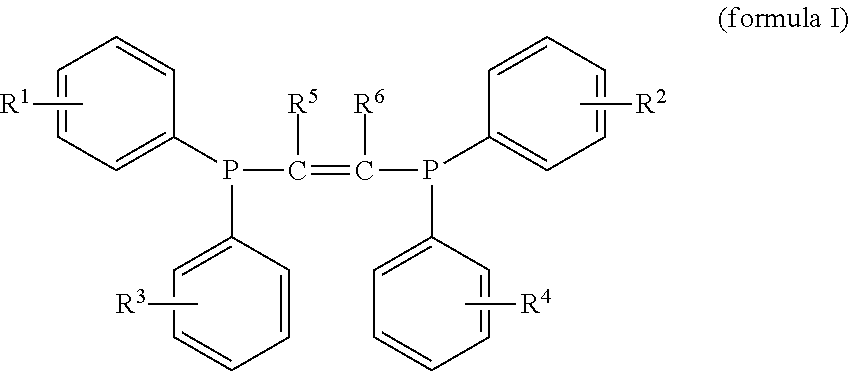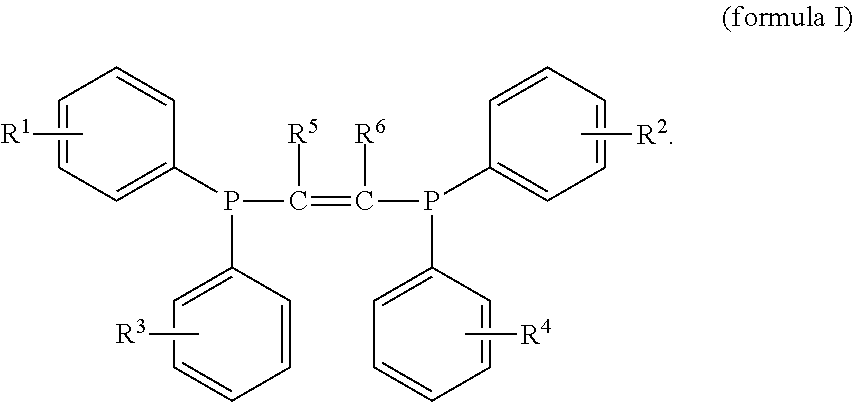Halogen-containing compound and use thereof, catalyst composition, and ethylene oligomerization, trimerization and tetramerization methods
a technology of ethylene oligomerization and ethylene oligomerization, which is applied in the field of halogen-containing compounds, can solve the problems of poor stability, complicated synthesis steps, and general disadvantages of the above-mentioned catalysts, and achieves improved catalytic performance in the ethylene oligomerization reaction, high initiation speed, and improved catalytic performance. the effect of the catalytic performance of the catalyst system
- Summary
- Abstract
- Description
- Claims
- Application Information
AI Technical Summary
Benefits of technology
Problems solved by technology
Method used
Image
Examples
preparation example 1
[0106]Preparation example 1 was used to prepare a halogen-containing compound I1.
[0107]
[0108]The halogen-containing compound I1 may be prepared with reference to the above reaction formula, with specific steps as follows:
[0109]Under the protection of nitrogen, n-butyllithium (11 mmol) (6.6 mL of n-butyllithium in hexane, the concentration of n-butyllithium being 1.6 M) was added into a reaction flask containing 15 mL of dry tetrahydrofuran, the mixture was cooled down to 0° C., 2.2 g (10 mmol) of difluorophenylphosphonium chloride was added under stirring, then acetylene (11 mmol) was added, stirring was continued to be performed for 0.5 h, then the temperature was raised to room temperature (25° C., the same below), and stirring was continued to be performed for 2 h. A catalytic amount of CuI and cesium carbonate were added, then 2.2 g (10 mmol) of difluorophenylphosphonium chloride was added, the temperature was raised to 90° C., and stirring was performed for 4 h at 90° C. After ...
preparation example 2
[0112]Preparation example 2 was used to prepare a halogen-containing compound I2.
[0113]In this preparation example, the halogen-containing compound was prepared by the same method as the preparation example 1, except that the difluorophenylphosphonium chloride was replaced with dichlorophenylphosphonium chloride. The prepared compound was subjected to nuclear magnetic resonance analysis, and it may be determined that the prepared compound was the compound represented by the formula I, wherein all of R1, R2, R3 and R4 are chlorine and ortho-substituents, and R5 and R6 are hydrogen.
[0114]H1NMR (400 MHz, CDCl3): δ=7.30-7.00 (m, 16H), 5.18 (s, 2H).
preparation example 3
[0115]Preparation example 3 was used to prepare a halogen-containing compound I3.
[0116]
[0117]The halogen-containing compound I3 may be prepared with reference to the above reaction formula, with specific steps as follows:
[0118]Tert-butyl acetylene (11 mmol) and 15 mL of dry tetrahydrofuran were added to a 50 mL reaction flask under the protection of nitrogen, and then n-butyl lithium (11 mmol) (6.6 mL n-butyl lithium in hexane, the concentration of n-butyl lithium being 1.6M) was added dropwise at 0° C. After the addition dropwise was completed, the mixture was continued to be stirred at 0° C. for 30 min, and subsequently 2.2 g (10 mmol) of difluorophenylphosphonium chloride was added dropwise. After the addition dropwise was completed, the temperature was raised to room temperature (25° C., the same below), and stirring was continued to be performed for 2 h. A catalytic amount of CuI and cesium carbonate were added, then 2.2 g (10 mmol) of difluorophenylphosphonium chloride was add...
PUM
| Property | Measurement | Unit |
|---|---|---|
| molar ratio | aaaaa | aaaaa |
| molar ratio | aaaaa | aaaaa |
| molar ratio | aaaaa | aaaaa |
Abstract
Description
Claims
Application Information
 Login to View More
Login to View More - R&D
- Intellectual Property
- Life Sciences
- Materials
- Tech Scout
- Unparalleled Data Quality
- Higher Quality Content
- 60% Fewer Hallucinations
Browse by: Latest US Patents, China's latest patents, Technical Efficacy Thesaurus, Application Domain, Technology Topic, Popular Technical Reports.
© 2025 PatSnap. All rights reserved.Legal|Privacy policy|Modern Slavery Act Transparency Statement|Sitemap|About US| Contact US: help@patsnap.com



